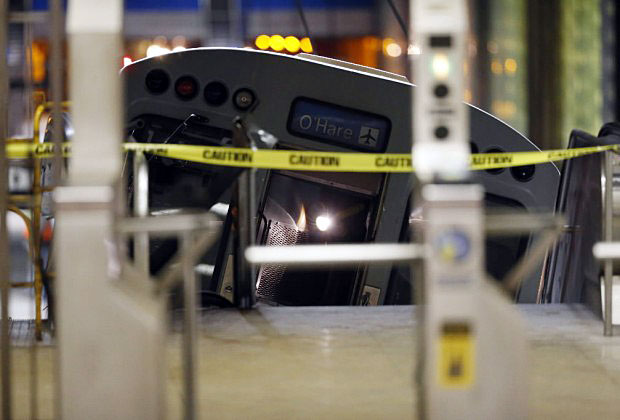This morning, I was out in the suburbs, preparing a two-mode commute to the office, when the news informed me that 1) a spectactular derailment of a Blue Line train at O'Hare had injured 32 people and sent a train car shooting up the escalator to the terminal 2) and a rollover crash on the Dan Ryan had killed one person and, through a complicated series of events, shut down the Red Line.
By the time everyone had made it on their various modes and gotten to the office, it got us wondering what the safest method of doing so was. For obvious reasons, the Blue Line derailment is national news—and the rollover is barely a footnote for the local news. But it's worthwhile to put each incident in perspective. Besides, it's an interesting question.
Broadly speaking, transit is considerably safer:

But what about in Chicago specifically? What if you include injuries? For that, we need to do math.
In 2011, according to the Chicago Metropolitan Agency for Planning, there were 20,422 non-fatal motor vehicle injuries in Chicago (119 fatalities).
To make that more of an apples-to-apples comparison, it's easier to look at it as injuries per 100 million vehicle miles traveled. In 2011, there were 182 injuries per 100 million VMT in Chicago, according to CMAP.
Now, on to the CTA. According to NTD data, there were 649 injuries to passengers in 2011—32 in one dramatic crash is a lot, but it's not a huge percentage of a typical year—and 336 injuries to "revenue facility occupants," i.e. "individuals waiting for or leaving transit."
Let's include them both, for a total of 985, since waiting for and exiting the bus or train is part of the process. (There were 164 operator injuries, which I'm not including.)
Then we convert that to apples. The CTA reported 2,121,635,238 passenger miles traveled in 2011. Over two billion. (Which sounds like a lot, and it is, but it's about 1/6th of New York's transit agency. In 2011, Chicago was fifth behind New Jersey Transit, the Metro North Commuter Railroad in New York, and the Los Angeles Metro authority.)
Those 985 injuries amount to 47 per 100 million passenger miles traveled, much lower than that for vehicular injuries.
Calculating whether biking is safer than driving or taking the CTA is much harder—really, it's impossible, as WBEZ's Curious City found, since we don't have anything like VMT for bikes—but I think we can safely say that it's not safer than public transportation.
In 2011, there were 1,302 injuries and seven cyclist fatalities in the city in car-related crashes—and an estimated 15,000 daily bike commuters in 2010, though obviously not everyone on a bike in the city is commuting—compared to 985 injuries, zero passenger fatalities, and two revenue facility occupant fatalities. (There were a total of 11 CTA fatalities in 2011, but nine were suicides.)
So, if I'm just playing the odds, I'd personally take the bus—but the best way to make cycling safer, actually, is more cyclists.



